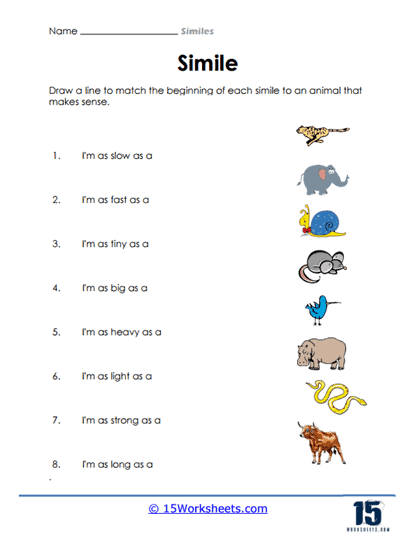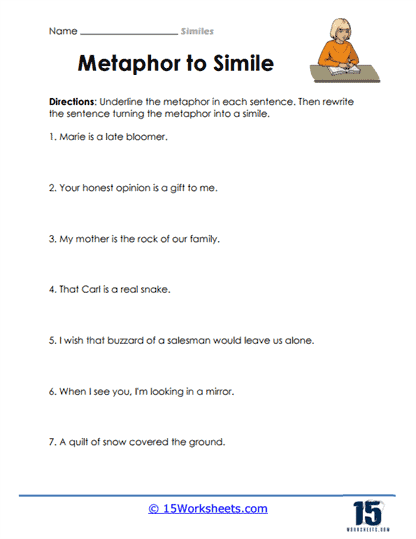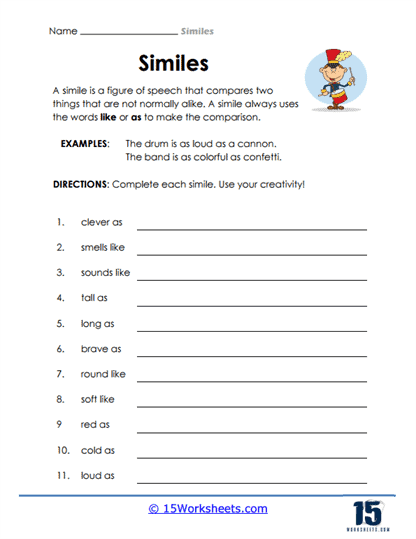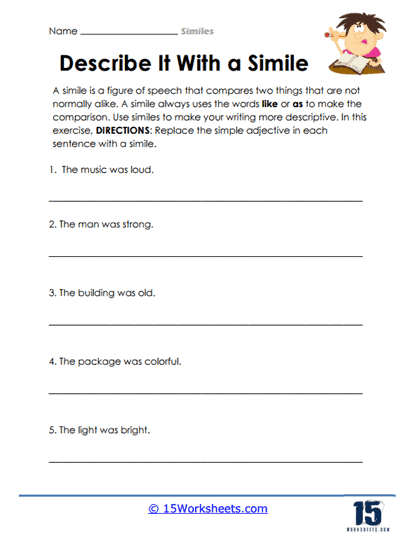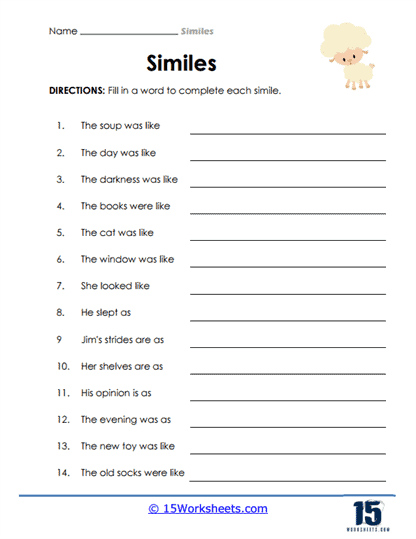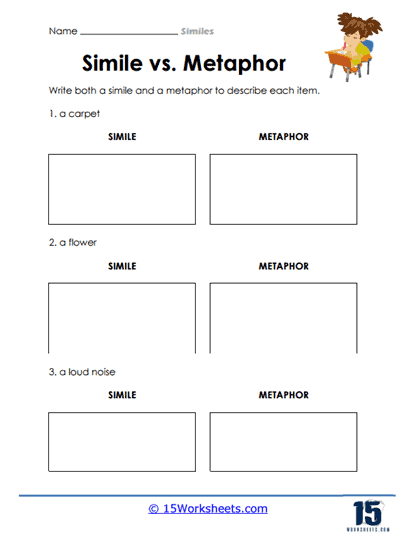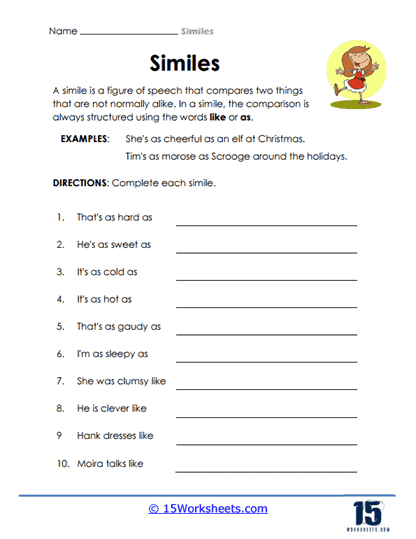Similes Worksheets
About These 15 Worksheets
These worksheets help you understand and practice using similes in language. A simile is a figure of speech that compares two things using the words “like” or “as.” It’s a way of saying that one thing is similar to another thing.
To explain similes, let’s look at an example – Imagine a sentence that says, “Her smile is as bright as the sun.” This sentence is a simile because it uses the word “as” to compare the brightness of the person’s smile to the brightness of the sun. It helps us understand the intensity and warmth of the smile by likening it to the qualities of the sun.
Simile worksheets provide exercises and activities that help you recognize, identify, and create similes in sentences or descriptions. These worksheets often contain examples of sentences or phrases, and you have to identify the similes and understand the comparisons being made.
By working on simile worksheets, you can:
Identify Similes – Simile worksheets help you develop the skill of recognizing similes in language. By reading sentences or passages, you learn to identify phrases or expressions that use “like” or “as” to compare things. This skill allows you to appreciate the creative and imaginative use of language in making comparisons.
Understand Figurative Language – Simile worksheets allow you to explore the figurative meanings of similes. You learn how similes create associations and enhance descriptions by comparing one thing to another. By understanding similes, you gain insight into the power of language to evoke imagery and convey emotions in a more vivid and engaging way.
Enhance Descriptive Writing – By learning about similes, you enhance your own descriptive writing skills. Similes provide a tool to make your writing more expressive and evocative. By practicing similes through worksheets, you develop the ability to incorporate this figure of speech into your own writing, creating vivid descriptions and adding depth to your storytelling.
Foster Creativity and Imagination – Similes encourage creativity and imagination. By making comparisons between seemingly unrelated things, similes prompt you to think in unconventional ways and make connections. Working on simile worksheets fosters a mindset of creative thinking and encourages you to explore different ways of expressing ideas.
Appreciate Language Variety – Simile worksheets foster an appreciation for the diversity and richness of language. Similes highlight the versatility of words and the myriad ways in which things can be compared. By exploring similes, you develop a deeper understanding and appreciation for the beauty and artistry of language.
Why Do Authors Use Similes In Their Work?
Authors use similes in their work for several reasons:
Enhancing Descriptions – Similes are used to create vivid and imaginative descriptions. By comparing one thing to another using “like” or “as,” similes make descriptions more engaging and memorable. They help readers visualize and understand the qualities of an object, person, or situation by drawing parallels to something familiar. Similes add depth and richness to the imagery of the writing.
Eliciting Emotions – Similes can evoke emotions and create a specific mood or atmosphere. By comparing something to an emotion or a sensory experience, similes tap into the reader’s feelings and create a stronger emotional connection. For example, “She was as cold as ice” or “His laughter was like music to my ears” evoke specific emotional responses and enhance the reader’s engagement with the text.
Making Complex Ideas Accessible – Similes simplify complex ideas or abstract concepts by relating them to something more familiar. By using a simile, authors can make the unfamiliar more relatable and accessible to readers. Similes help bridge the gap between the abstract and the concrete, aiding readers in understanding and connecting with complex themes or ideas.
Creating Memorable Language – Similes make language more memorable. They provide unique and imaginative ways of expressing ideas and create distinctive images or phrases that stick in the reader’s mind. Similes contribute to the overall aesthetic quality of the writing and make it more enjoyable and impactful.
Adding Depth and Nuance – Similes add layers of meaning and depth to the writing. They allow authors to convey subtle nuances or qualities that may be challenging to express directly. Similes can capture the essence of a situation, character, or emotion in a concise and evocative manner, enriching the reader’s understanding and experience of the text.
Engaging the Reader’s Imagination – Similes stimulate the reader’s imagination and invite them to make connections. By comparing one thing to another, similes encourage readers to think beyond the literal meanings of words and explore the deeper associations or implications. Similes engage the reader in a more active and participatory reading experience.






